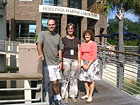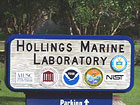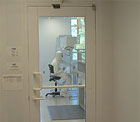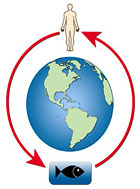

 | |||||||||||||||
|
|
Journals 2006/2007Anna Hilton
March 25, 2006
I am so excited to have been selected by the ARMADA Project to join scientists in real conservation research. Conservation research means that scientists carefully study and investigate our natural world for the purpose of protecting and preserving it. I will share my research experience with my fourth grade science classroom at Jennie Moore Elementary and with a new elementary science teacher in Charleston County. Move over Mrs. Frizzle in your Magic School Bus, here is Mrs. Hilton, fourth grade science teacher, ready to do real conservation research at Hollings Marine Center (http://www.hml.noaa.gov). The Hollings Marine Laboratory (HML) is a Center of Excellence in Oceans and Human Health. The center is located at the South Carolina Marine Resources Center in Charleston. Thank you to the ARMADA Project funded by the National Science Foundation and to the Hollings Marine Laboratory for this important opportunity. The ARMADA team put me in touch with Susan Lovelace who is the educational coordinator at the Hollings Marine Laboratory. Her job is to share the results of the research at HML with the public, including teachers and students of all ages. Susan invited me on a tour of Hollings Marine Laboratory led by the director, Fred Holland, Ph.D. The tour was amazing and fantastic! Hollings Marine Laboratory is all about team work. Five state and federal research partners join at Hollings Marine Laboratory in a team effort to understand how the marine environment links to marine life and human health.
The HML partners conduct their scientific research using the same methods we learn at school. Dr. Fred Holland said when it comes to science there is only one method - the scientific method! Scientists at HML begin their research in the same way we begin our investigations in fourth grade science class- with questions! The research goals of the Hollings Marine Laboratory center on answering these questions:
The science research at HML studies the effects of toxic substances and especially pollutants on the marine environment. The hypothesis of the research at Hollings Marine Laboratory is that development near our coastal ecosystems is harmful to the health of our oceans and harmful to human health. HML designs new tools to test toxic substances and pollutants in the ocean water and soil. The tour took us through the laboratories of the different research partners working at HML. Many of the scientists were using the same black and white composition books we use for our science journals at school. The scientists are interested in saving money just like your parents. We went upstairs to see the Marine Environmental Specimen Bank (ESB). Suddenly I felt like I was in a sci-fi movie. The laboratories on this floor use cutting edge technology! The ESB is a huge library of well documented and preserved marine environmental specimens. The samples are stored at extremely low temperatures (cryogenic storage). Scientists must enter the ESB through a cleanroom to put on special lab clothes so that they do not contaminate the specimens with dirt or dust. Robots also do some of the work in the laboratory. Emergency generators have to be in place in case extreme weather (hurricanes) cause a power outage in the air conditioned lab. Don't you wish we had robots at school?
Hollings Marine Laboratory is the only marine research laboratory with Nuclear Magnetic Resonance (NMR) (http://en.wikipedia.org/wiki/NMR_spectroscopy) capability. Our tour guide, Fred Holland, became very excited when he described this cutting edge technology. These very big magnets are very expensive equipment (5 million dollars) and take up over 5,000 square feet of lab space. NMR spectroscopy is used to obtain physical, chemical, electronic and structural information about a molecule. It is the only tool that can provide information on the three-dimensional structure of biological molecules in solution. This molecular information is important to see how toxins affect marine life and human health WOW! Scientists go on field trips. I am as excited about going on a field trip with real scientists as my fourth grade students are when we go on educational field trips. Actually the investigators at HML have set up very detailed procedures to analyze the soil, water, and the life in the marine environment. The researchers go into natural ecosystems to collect data for their investigation. They take water and soil samples to analyze in the lab. The researchers at HML look at how development changes the water and the soil around the marine ecosystems they study. Scientist look at how those changes affect marine animals and human health. Scientists have to control the research variables in the laboratory and in the field. Scientists work hard to understand their research data, but they realize that there might not be one definite answer to the complex questions they study. The specialized tools and collection procedures designed at Hollings Marine Laboratory will be used by scientists everywhere for evaluating the health of the ocean. Scientists often request specialized tools and also evaluate the tools developed at HML. This continual cycle of tool application and assessment keeps HML at the cutting edge of tool design. An interesting and effective cycle of tool assessment exists at HML. The conclusions of the investigations at Hollings Marine Laboratory will be communicated to the science community in hope that future generations will be able to protect and preserve our natural world.
|
||||||||||||||



